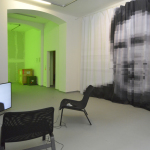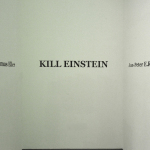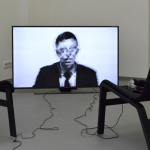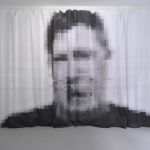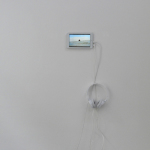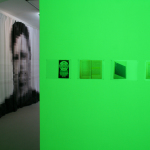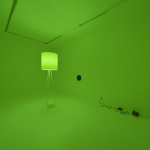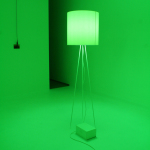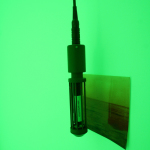KILL EINSTEIN
28.04. – 05.05.2016
THE – Thomas Eller
Jan-Peter E. R. Sonntag
When Albert Einstein first predicted the existence of gravitational waves in 1916, he hardly
believed himself that his theory would ever be detected. However, last February was reported
that this lack of proof had finally been confirmed: gravitation waves are reverberations
of the Big Bang, originated almost 13.7 billion years ago. In fact, what Einstein discovered
than has been scientifically proven and validated today. The process itself evades all kinds
of imagination; it seemed to have place only in academic descriptions. Thus, after the notification, if their existence announced last February, gravitational waves are now even
presented as a cartoon or in Big Bang animations. Yet, the more is proven by science, the
less space is left for the mystery of the universe and humankind. With his theories, Einstein
has transformed the way we think and attitude to science. We are grateful to him for this,
while are waiting impatiently for further speculations and future actions. “KILL EINSTEIN”.
Als Albert Einstein im Jahr 1916 seine Gravitationswellen postulierte, hat er selbst kaum daran geglaubt, dass seine Theorie jemals messbar oder evident werden könnte. Im letzten Februar kam dann die Meldung, dass der fehlende Beweis geführt werden konnte. Die Gravitationswellen sind der Nachhall des Urknalls, der sich vor ca. 13,7 Milliarden Jahren ereignet hat. Dass er tatsächlich stattgefunden hat, ist nun nachgewiesen und verifiziert. Der Vorgang selber entzieht sich jeder Vorstellungskraft und existiert quasi nur als akademische Beschreibung und nach der Meldung im letzten Februar eben als Cartoon oder Big Bang Animation. Je mehr aber wissen- schaftlich bewiesen werden kann, desto weniger bleibt dann Platz für das Mysterium des Universums und der Menschheit. Einstein hat mit seinen Theorien die Methodik unseres Denkens und der Forschung verändert. Für diese Veränderung danken wir ihm und doch warten wir auf Weiterdenkende und Tuende. „KILL EINSTEIN“.
THE - Thomas Eller
„…if I were not, God would not be: that God is God, of that I am the cause. If I were not, God would not be God.“ „God doesn´t play dice“, Einstein famously said. Thomas Eller’s work THE white male
complex(quis ut deus), 2016 negotiates the background radiation of an old universe that in the West stands largely abandoned. The recent wars in the Middle East however give rise again to the
suppressed metaphysical residue of Western culture. “God is dead”, Nietzsche famously proclaimed, the corpse, however, remains unburied. We are currently experiencing the full impact of terror
fuelled by the phantasies for almighty power of a self-proclaimed theocracy. What is the West’s answer to this?! – Countering ultra-conservative movements also in the West, Thomas Eller reminds us of
a cultural tradition in the West that allows for a positive approach to the question of god. One that does not give itself to become a mundane power of authoritarian discern. One also that liberates
the individual from the impositions by self-accredited worldly and spiritual leaders and instead creates an enlightened approach to the world: it is the mystical experience. In his video, the artist
himself reads „Beati pauperes spiritu, quoniam ipsorum est regnum caelorum”, a homily by Meister Eckhart. To the utmost horror for any orthodoxy, this sermon claims god’s origin to be the self. As
such, this exhibition also sheds new light on the complete works of Thomas Eller who for the past 25 years has been concerning himself with the question of the SELF.
THE - Thomas Eller is an artist and was executive director of the German branch of artnet AG , as well as managing director and artistic director of Temporäre Kunsthalle Berlin.Thomas Eller’s work THE white male complex (quis ut deus), 2016 negotiates the background radiation of an old universe that the West has left mostly abandoned. However, the recent conflicts in the Middle East brings the suppressed metaphysical residue of so-called Western culture back into conversation. Thomas Eller has received various prizes, including the Villa-Romana Prize and the Käthe-Kollwitz-Prize from the Akademie der Künste Berlin in 2006. He has been invited to participate in numerous international exhibitions and projects such as Gwangju Biennial; Solitude au Musée; Musée d’Art Moderne, Saint Étienne; Musée Imaginaire and Museum of Installation, London. In Berlin, he also co-curated ‘The 8 of Paths: Art in Beijing‘, at the Uferhallen.
THE – Thomas Eller ist Künstler und war Chefredakteur beim Magazin der artnet AG und Geschäftsführer der Tem- porären Kunsthalle Berlin. In seiner Arbeit „THE white male complex (quis ut deus)“ 2016, sucht Thomas Eller nach der Hintergrundstrahlung eines alten Universums, das man im Westen weitgehend aufgegeben hatte. Durch die Kriege im Nahen Osten jedoch bekommt die Frage nach verdrängten metaphysischen Resten in der westlichen Kultur neue Aktualität. Er ist Preisträger der Villa Romana Florenz und gewann in 2006 den Käthe-Kollwitz-Preis der Akademie der Künste Berlin. Teilnahme an zahlreichen internationale Ausstellungen und Projekten u. a. Gwangju Biennial, Soli- tude au Musée, Musée d’Art Moderne, Saint Étienne und Musée Imaginaire, Museum of Installation, London. Er war Co-Kurator der “Die 8 der Wege: Kunst in Peking”, in den Uferhallen, Berlin.
Jan-Peter E.R. Sonntag
Exactly 30 years after the Chernobyl accident and 10 years after its premiere at the Kitchen Gallery in New York Jan-Peter E.R. Sonntags GAMMAvert / a x-sea-scape will be presented at the inaugural show of DISKURS Berlin. A rather museum-like setting: the white cube, on the wall a timeless photograph: a seascape (shot from the Travemünder Ufer / the place where I grew up taken 10 years after Tchernobyl standing at the same position and remembering the same grey weather). On film, a chemical process has captured the reflected light of the shallow sea on a grey day. For the enlargement we work with a historic tinting process – a brownish-bronze sea – a process in which uranium nitrate is taken up by the photographic silver (also making the captured moment extremely durable). A highly sensitive radiological sensor measures the radiation in the room. A field of subsonic sinus waves pervades the exhibition architecture / the architecture is filled with green light - the "green ray" - swinging just on one frequency - an optical sinus-wave / the sediments of the Western Baltic exhibit specific activities between 2 (Arkona) and 190 (Eckernförder Bucht) Bq/kg. The white lamp has a human proportion - the special mercury gas mixture swings only in one frequency (3 bulbs had been produced for the installation by NARVA): total green like the last rays of the sun sometimes visible on the sea. a standing sine-pressure-wave structures the volume of the architecture while small flashes and clicks are counting the free gamma-isotopes.
"Have you sometimes observed the sunset over the sea? Have you watched it until the upper rim of its disc, skimming the surface of the water, is just about to disappear? Very likely you have: but did you notice the phenomenon that occurs at the very instant the heavenly body sends forth its last ray, which, if the sky be cloudless, is of unparalleled beauty? No, perhaps not. Well, the first time you have the opportunity of making this observation, and it happens but rarely, it will not be, as one might think, a crimson ray that falls upon the retina. It will be green, a most wonderful green, a green that no artist could ever obtain on his palette, a green the likes of which neither the varied tints of vegetation nor the shades of the most limpid sea could ever produce!" (Jules Verne "The Green Ray")
"The most immediately striking work was Jan-Peter E.R. Sonntag´s GAMMAgreen/x-seascape, 2006, an installation exploring the poetic confluence of wave-phenomena. Its impact was due in part to the eerie green light (a reference to the "green ray" observed on the marine horizon at sunset) that emanated from a lamp at the work´s center, thought the low-frequency "standing wave" that rumbled from a bass speaker added to an ominous atmosphere that distinguished the piece from the neighbors. the other audible component of the work was an intermittenet blip, accompanied by a tiny flashing light, indicating that a snapshot of a seascape hanging on the adjacent wall remained radioactive, having been developed using uranium nitrate. The picture was no more dangerous than the glow-in-the-dark hands of an alarm clock, but the idea of suffusing a space in unseen frequencies retains an edgy poetic"
in Michael Wilson in ARTFORUM, November 2006
"Man muss die Strahlung nicht notwendig mit jener assoziieren welche den Sedimenten der Ostsee naturgemäß eignet und auf die der Künstler in seinem Begleittext zur Installation verweist. Gleichwohl fügt sich diese Information perfekt in das System der Bezüge, in dem sich dieses Werk entfaltet: Schnittstellen von Kunst- und Wissenschaftsgeschichte werden nicht nur als Referenzgrößen zitiert, sondern begegnen sich in einem ästhetisch erfahrbaren Gesamtgefüge und werden für die Kunst neu erschlossen. Genau diese Vorgehensweise ist charakteristisch für Jan-Peter E.R. Sonntags Arbeiten, zu deren zentrale Fragestellung gehört, wie jenseits der vorgeblichen Abgeklärtheit so genannter post-moderner Positionierung und eines spielerischen, modischen Zitat-Pops das Erbe der Moderne fruchtbar gemacht werden kann. Diese Fragestellung bildet den Ausgangspunkt für komplexe Projekte, die sich oftmals über Jahre weiter entwickeln. In die wortwörtlich multimedial operierenden Installationen fliessen Forschungen ein, an denen der Künstler in direktem Austausch mit Wissenschaftlern und Technikern zusammen arbeitet."
Verena Kuni "Auf der Suche nach dem Wesen der Dinge und ihrer Wahrnehmung – über Jan-Peter E.R. Sonntags Labortorien der Sinne" in KUNST-BULLETIN 3, 2007
Jan-Peter E.R. Sonntag is an artist, composer and researcher. He studied fine arts, art history, music theory, composition, philosophy and cognitive science. He has exhibited in various international exhibitions and received several grants or prizes such as Akademie Schloss Solitude, Berlin-& German Sound Art Prize and the Villa-Aurora-Grant in LA, USA, among others. Since 2012 he is running a media-epistemological research project on Friedrich Kittlers Synthesizer; since 2014, he is one of the publishers of Kittlers collected writings. In 2015 he had a solo show at the WKV in Stuttgart – RAUSCHEN; his chamber opera SINUS about Herman von Helmholtz was shown at the TAT in Berlin and his video- & sound-installation SONNTAG IM PARK was part of Xenopolis at the Deutsche Bank Kunsthalle in Berlin.
Jan-Peter E. R. Sonntag ist Künstler, Komponist und Theoretiker, Er studierte Kunst, Kunstgeschichte, Musikwissen- schaft, Komposition, Philosophie und Kognitionswissenschaft und „betreibt Wissenschaft mit den Mitteln der Kunst” (Verena Kuni). Er nahm an zahlreichen internationalen Ausstellungen & Festivals teil und erhielt zahlreiche Stipendien und Preise u. A. so den Berliner Klangknstpreis, den Deutschen Klangkunstpreis, war Stipendiat der Akademie Schloss Solitude und der Villa Aurora. Seit 2012 betreibt er ein medien epistemologisches Forschungsprojekt über Friedrich Kittler Synthesizer und ist seit 2014 Mitherausgeber von Kittlers gesammelten Schriften. 2015 hatte er eine umfassende Einzelausstellung im WKV Stuttgart – RAUSCHEN und realisierte seine 3. Kammeroper – SINUS im Tieranatomis- chen Theater, Berlin um Herman von Helmholtz “Lehre der Tonempfindung” und eiiner apparativen Neuinterpreta- tion des Helmholtzen Apparates zur Kombination von Vocalklängen – eines ersten Synthesizer aus der Mitte des 19. Jahrhunderts.

